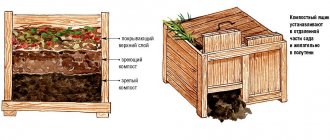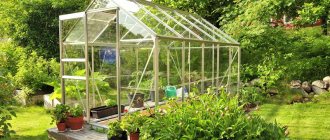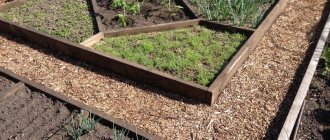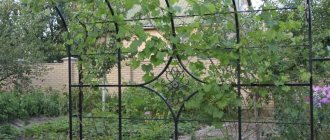Grape gazebo A do-it-yourself grape gazebo decorates the leisure time of its owners and delights with sweet fruits. This beauty will definitely be appreciated by family and friends.
At the same time, the frame for the gazebo can be made quite simple and not too expensive, and the climbing grapes will make it exclusive and fabulous. The article will tell you how to make a gazebo for grapes yourself.
Various types of structures
Before building a gazebo, you need to decide in advance on several issues:
- what the gazebo will be used for;
- where will it be installed;
- what sizes, style and shape to choose;
- what materials to build from;
- how to decorate it.
According to the method of use they are divided:
- for outdoor gatherings;
- for preparing various dishes outdoors as a summer kitchen. Stoves, barbecues, and barbecues are installed inside or near it;
- as relaxation areas with rocking chairs, hammocks, spa pool and fireplace;
- for relaxing near the pool
- for the equipment of a summer cinema;
- for outdoor gymnastics;
- for a cozy rest in the middle of nature;
- for admiring natural scenery by a lake or river.
It can be installed:
- near the house, so that it is convenient to bring dishes and ready-made dishes;
- in the center of the site to enjoy landscape views of the site;
- on the edge of the plot, in a place hidden from prying eyes, to bask in solitude;
- outside the site.
Depending on the size of the family and friends visiting the site, suitable sizes of the gazebo are designed. Its length can be almost any, and its height is standard. The optimal height is 3–3.5 m. This height is convenient both for humans and for caring for climbing plants.
The appearance of the gazebo should be in harmony in style with the house and the site itself. For production, any building materials are used:
- tree;
- logs;
- metal;
- forging;
- brick;
- stone;
- polycarbonate
The shape of the gazebos is also very diverse:
- quadrangular;
- polygonal;
- round;
- combined.
The gazebo can be grown from trimmed linden trees or grapes entwined with metal supports. It can be made open, semi-open, closed, in the form of a canopy; it may or may not have a floor covering, a window and a door. But the gazebo must have a roof, although its shape also depends on the owner’s imagination.
Depending on the type of house and the wishes of the owner, structures are built in the following styles:
- classical;
- Oriental;
- natural;
- rustic.
The last stage of construction is decoration. In addition to various forged garden figurines, weather vanes, and lighting, the main decoration for the gazebo are climbing plants. There are not very many of them in our cold climate:
- clematis;
- roses;
- annual vines (decorative peas or beans, climbing nasturtium, morning glory);
- decorative and fruit grapes.
No matter how beautiful roses and clematis are, traditionally in Russian gardens they like to plant grapes near the gazebo, with which there is much less hassle, and the pleasure of harvesting a good harvest is much greater.
It is better to plant grapes on the south or southeast side of the gazebo. This must be taken into account during its manufacture and the entrance should not be placed on the indicated sides.
A gazebo for grapes should correspond not only to human ideas about comfort, but also to plant ones. Otherwise, instead of lush vegetation that brings a good harvest of excellent grapes, you can get a stunted vine with sour and small clusters.
Beautiful options for gazebos for grapes
The grape arbor on the site is an amazingly beautiful structure. The frame for it is easy to build, inexpensive, and the result is visible already in the first season. You can assemble a light and simple canopy at the entrance to the house. But real aesthetes create vine arches, galleries, green rooms, fairy-tale houses or entire labyrinths on their site. If the buildings are decorated with a green top covering, they act as beautiful shady gazebos.
Gazebos are divided into seasonal, which are assembled in the warm season and hidden in winter, and stationary, built thoroughly for any season. The former are equipped with plants in pots and flowerpots, the latter are landscaped with perennial grapes and other types of climbing plants. The permanent buildings are beautiful and varied. Their frames have different textures. They can be made of metal, stone, brick or wood, and may contain combined building materials.
You should know that wood is not very suitable for creating grape gazebos. Some species of this plant live up to 200 years. A tree exposed to moisture from watering will rot much earlier. But the beauty and environmental friendliness of this material attracts many who prefer it.
When starting the construction of a gazebo, you need to know for what purposes it will serve and what functions it will perform.
The gazebo for relaxation can be tent-shaped or dome-shaped. If a vacation is planned with a barbecue and friends, the dimensions of the building are assumed to be voluminous and capital. According to fire safety standards, such a gazebo should be located at a distance of six meters from any buildings. It can be square, rectangular, polyhedral or indeterminate in shape. A gazebo attached to a building usually serves as a shady shelter at the entrance to the house. It is quite budget-friendly, as it requires the construction of only one wall and a top covering.
Miniature gazebos are installed in gardens to decorate the landscape as an addition to decorative streams and fountains. A gazebo for cozy relaxation is arranged in a shady corner of the garden. On a hill, an aerial structure resembling an observation deck is usually used. The variety of species lies in the geometry of the structure.
They can be round, dome-shaped, multifaceted, arched, square, irregularly shaped, attached to the building, pergolas, trellises under a canopy.
The arched shapes of the arched structure, if installed correctly, without distortions or deformations, look very attractive.
To create an arch you will need to do the following:
- for a green arched gazebo, the frame is assembled from metal rods;
- it is necessary to prepare concrete, gravel or broken brick, as well as thick wire;
- They dig holes and lay gravel on the bottom;
- the rods are bent in an arc, the ends are inserted into the prepared holes and filled with cement, creating the base of the arched frame;
- for structural strength, several transverse rods are mounted by welding;
- the remaining horizontal fastenings are formed using strong wire.
Trellis structure with canopy
This type of gazebo is made from reinforcement, pipes or wood.
The following algorithm should be followed:
- mark and dig holes in which supports are installed;
- the racks are filled with cement;
- vertical and horizontal fasteners are mounted between the supports, creating a trellis for grapes;
- the roof is formed in the same way; it can be made flat or sloped in the direction of the sun; sometimes a continuous covering (canopy) is built to protect from rain;
- to create an ideal structure, vertical supports are checked with a plumb line, and horizontal fastenings with a level;
- It should be taken into account that a gazebo that is too high is difficult to maintain; in order to form shoots, you will have to reach the top covering.
Round varieties
Such a structure will decorate even a small courtyard.
To create such a design, you should perform the following steps:
- supports made of pipes or wooden beams are installed in prepared holes in a clearly defined circle;
- leave the entrance to the gazebo on the intended side;
- a solid base is mounted in a circle at the top, to which the conditional roof will be attached; the rods at an angle are connected at one end to the base, and at the other end they are collected at the top point;
- it is not difficult to form a green gazebo of this design - two vines are planted at the entrance on both sides, young shoots are directed in a circle and slightly upward;
- when forming a gazebo, the shoots must be tied up and excess growth removed; if done correctly, grapes can surround a building in one season, resulting in a cute fairy-tale house with a domed top.
Gazebo designs
The construction stages are standard for any construction:
- layout;
- choice of location;
- construction;
- decoration (painting, planting plants next to it).
Gardeners build a grape arbor with their own hands quite often. If you decide not to buy a ready-made structure, but to do everything yourself, then you should start with the layout.
Most often, gazebos are placed in the depths of the garden, between trees, at a distance of 3–5 m from a residential building. If there is a hearth with a live fire in it, then it is better to place it no closer than 8 m from the house.
Before construction, it is useful to prepare a project in which, in addition to a drawing with calculations of the dimensions of the future building, a calculation of the amount of material used will be made.
The gazebo drawing must take into account the type of foundation chosen. It can be columnar, tape, screw or monolithic. The cheapest and most optimal for small gazebos is a columnar foundation. There is often no floor in the structure, and the base is made of tiles.
The minimum width of a building for resting 4 people is 1.5 m, length 1.5–2 m. In general, when designing, it is worth remembering that to comfortably accommodate 1 person, an area of 2 sq. m is required. m. If you plan to relax in armchairs and sun loungers, then take 4 sq. m. per person. Based on this, you can calculate the area of the future structure.
When installing a barbecue or stove on the territory of the gazebo, a minimum of 2.4x1.75 m must be added to its area, and for comfortable placement - 3.4x2.2 m.
The design of a gazebo in the form of a polygon is a little more complicated than a rectangular one, but such buildings look more interesting and impressive. To make drawings of such a design, you will have to remember the rules of geometry from the school course, so as not to violate the proportions of the faces.
Sometimes, instead of a building for grapes, a passionate gardener erects a gazebo made of grapes. They look very good at the end of a path or in the space between the house and the entrance gate.
A gazebo made of uncovered grapes is built with your own hands from simple materials and does not require large material costs or a lot of labor. It consists of two pillars with rounded arches. These can be pipes curved in the shape of a dome. The weight of an adult grape bush is not small and the supports under it must be strong and durable.
The supports of the gazebo or arch are installed along the path, retreating from it 30 cm on each side, the height of the arch is no more than 2.5 m.
The grapes are planted in a row along the entire length. It is necessary to choose varieties that are resistant not only to frost, but also to winds. Hybrids of the Isabella variety of American selection have this characteristic. You can use grapes:
- Victoria;
- Agate;
- Beauty of the North;
- Kishmish is unique.
A beautiful grape arbor always attracts the attention of any garden visitor. After all, its existence is impossible without careful and competent care of the vine.
Capital gazebos on the foundation
Scheme of a capital structure.
These are already more powerful and solid buildings that require a serious approach and significant costs.
Where to start if you decide to settle in a big way?
- Decide on a location for the gazebo and its size, shape and style.
- Please note that the instructions do not advise building too close to neighboring buildings . You will get in each other's way and rest may become a problem.
- After marking, the foundation is built . Depending on the capitality of the future gazebo, as well as on the properties of the soil, a shallowly buried strip, pile or columnar structure can be made. Stock up on sand, cement and gravel.
The sides of the building can also be covered with trellises.
- The sides of the building in such cases are usually closed . The material can be anything - stone, timber, lining, boards and even logs. It depends on the style you choose. The height of the mini-walls should be such as to prevent drafts at the bottom, but not block the view of those sitting. Optimally it is from 50 cm to 100 cm.
- Treat your flooring responsibly . Since the structure will be partially open, moisture may get onto the floor, which means you will have to use a waterproof material. Or impregnate all wooden elements with a special composition that prevents rotting. Ceramic tiles or a special decking board will look good on the floor.
- Before making a grape gazebo, consult a stove specialist, if you have one . Better yet, use his services. He will professionally lay out a fireplace, grill or stove for the gazebo.
- Build according to style . It can be rustic analogue, artsy rococo, Roman, oriental, futuristic or any other. Depending on your region, select frost-resistant grape varieties for your gazebo. Proper insulation for the winter will prevent the vine from dying.
Main stages of construction
Until recently, the frame of the gazebo was most often made of wooden blocks. After all, wood is a light, durable and cheap material that is convenient to work with. In addition, the tree always fits organically into any landscape.
The construction of an ordinary quadrangular gazebo with a side of 3.8 m will take 1.5 cubic meters. m of lumber. The standard roof slope must be at least 30°, then neither water nor snow will linger on it.
However, the known disadvantages of wooden structures: increased risk of fire, susceptibility to rot, and the appearance of cracks have led to the fact that wood is increasingly being replaced by metal structures.
The construction of the gazebo is proceeding in stages:
- Marking the base.
- Foundation equipment.
- Installation of the frame (lower frame, vertical supports, top frame).
- Laying the floor.
- Roof installation (rafters and roofing).
- Arrangement of a gazebo.
Whatever the design, the support of the gazebo will be the foundation. For lightweight structures, a columnar foundation is chosen. This is the cheapest option, and also easy to construct. The depth of the foundation supports into the ground must be at least 180 cm.
After the foundation, the assembly of the frame begins, for which the lower frame is laid. Most often these are square logs. Between the foundation and the lower trim, waterproofing is laid, for example, roofing felt.
Vertical support bars are installed on the harness. Four main pillars on each side will form the foundation of the structure. Their number depends on the size of the gazebo. At the end of the frame assembly, the support beams are connected with the top frame using the same method as the bottom frame.
Trusses for the rafters are made in advance and then fixed to the frame. The lower part of the rafters should be extended as far as possible beyond the perimeter to protect the gazebo from water from the roof. After all, installing ebb tides on the roof is not practiced.
The construction of the gazebo ends with laying the roof. Whether to use metal or wood roofing materials is a matter of personal taste.
After construction is completed, the structure is painted, furniture is installed, lighting is provided, and ornamental plants are planted.
Benches in a small building are often built around the perimeter to accommodate more people.
Often gazebos of simple design are erected in order to plant grapes around it. In this case, you should think in advance about reliable support for it. The grapes tightly entwine the building; it is impossible to remove them from the walls for painting or repairs.
For poles under the arbor for grapes, you can choose wooden or metal supports. The main thing is that the grape bushes should be planted correctly: the distance between them and the lighting.
Supports made of other materials, such as stone or brick, are rarely used. However, grapes will feel good near such walls if you attach a wooden or metal lattice to them.
Several types of supports are used in the design of a gazebo for grapes:
- trellis;
- arch;
- semi-arched canopy.
The wall of the structure is made in the form of a trellis: a row of pillars with a cable or rail stretched between them at a height of 0.5 m from the ground. The distance between adjacent rows of cables is 03–0.4 m. The height of the structure is usually no more than 3.2 m.
A semi-arched canopy is good for a small area, when the gazebo is used as a support for growing grapes. Often such a structure is attached to a house. So, two problems are solved in one place. Near such a gazebo, grapes are planted in one row.
The arch is good for construction on spacious plots of land. This option is good in the front part of the site, at the entrance or entrance to the house. The arch is more difficult to manufacture and requires welding. Planting grapes near it is carried out in two rows.
How to make a gazebo for grapes. Pipe structure
Most often, a profile pipe is used to build such cozy green corners.
Using this material, you can make either a regular gazebo with steep walls, or an arched, multifaceted or even domed one. Note: If you don’t have a pipe bender at hand, you can ask to bend the pipes as needed where you will buy them. Typically, companies selling such products provide this service for an additional fee.
A simple “green” canopy made of grapes on a frame made of corrugated pipe
So, let's see how to build a gazebo under grapes with your own hands. The frame manufacturing procedure includes the following steps:
- Markings are made for the gazebo on the ground.
- Then, in increments of about two meters, holes are dug for the pipes. Their depth should be about 70cm.
- Sand is poured into the bottom of the holes and a little solution is poured.
- Then they begin to install and pour concrete into the racks.
Frame stands for grapes are poured with concrete
- Between them - at a height of 70 cm from the ground level - cross members are welded. The next horizontal tier is placed at a distance of 35-40cm from the first. Next, the third tier is mounted in the same way. The distance from it to the top trim should also be 35-40cm. The cross members are also mounted on the roof with the same step.
Gazebo under grapes. Photo of the finished frame
Important: Before installation, all metal elements of the frame must be painted with acrylic enamel intended for outdoor use.
When planting vines, be sure to follow the required agricultural practices. In this case, you will get a very beautiful grape arbor. Planting is done with your own hands in flower beds arranged around the perimeter with soil of the required composition poured into them. Seedlings are placed two per opening. After planting, just above the top of the cuttings, a 3mm wire is pulled between the posts. It is needed to give the vines the direction of growth. The grapes are further formed by cutting off the top.
Scheme of planting grapes for arranging a “green” gazebo
Tip: Intermediate crossbars can be made from rod or also from thick three-millimeter wire.
A do-it-yourself grape gazebo can also be built using timber. But this method has one serious drawback. The fact is that grapes grow in one place for up to 200 years. Wood in the ground - even treated - will begin to rot within 10-15 years.
Suitable grape varieties
The simplest fast-growing vine that does not require shelter is the decorative vine. In just a few years, it will thickly entwine any gazebo, creating a pleasant coolness in it on hot summer days.
Its advantages, in addition to rapid growth, absolute winter hardiness and unpretentiousness, include a beautiful autumn appearance. Before winter, the grapes change the color of their foliage to a bright crimson outfit. Surfaces entwined with grapes look very impressive.
In the regions of the central part of the country, you can plant several varieties of this non-killable plant:
- Amur bisexual;
- Taiga;
- Bruskam;
- Khasansky sweet.
But if you choose from plants with edible berries, then non-covering grape varieties for the gazebo should be selected taking into account the weather characteristics of the region.
In addition to winter hardiness, it is necessary to choose a variety that grows well with minimal care and produces berries with good taste. The length of the plant and the uniform distribution of shoots in the crown are also important.
To get a good harvest of grapes on the supports of a gazebo or arch, it is worth planting early ripening varieties and hybrids.
In the southern regions there are no difficulties with choosing; there are quite enough good varieties.
The following varieties are well suited for the natural zone in the middle regions of the country:
- Isabel;
- Lydia;
- Ontario;
- Amethyst.
In addition to varieties, you can use numerous winter-hardy hybrids:
- Shunya;
- Summer Muscat;
- First-Called;
- Alyoshenkin.
For the more southern Black Earth Region, choosing varieties is also not easy, since in this natural zone the soil often freezes deeply in winter. Suitable varieties:
- Delight;
- Codrianka;
- Beauty of the Don;
- Tukay.
Hybrids with a short ripening period at the end of summer are also suitable for this zone:
- Arcadia;
- Agat Donskoy;
- Bulgaria is resilient;
- Pulse.
The grapes on the arbor are formed in the form of a vertical or fan-shaped bush. Row planting near a small structure is not suitable, there will not be enough space. If the distance is thickened, the berries will grow small and tasteless due to lack of lighting. Each plant must account for at least 3 m of the length of the arbor.
Gardeners use several methods for forming a grape bush on a support:
- Fan crown. This plant does not have a standard, the bush is formed from four branches about 1.5 m long, the clusters are located every 0.5 m.
- Vertical cordon. From the beginning of growth, a vertical trunk without lateral processes is formed. In the 2nd year they begin to grow branches at a height of 40 cm. The branches are shortened annually.
In addition to perpendicular posts, transverse connections are often used in gazebos. Then the bush is formed by a Moser cordon, when the vine is planted in the center of the structure and grows along the support equally in both directions.
Uncovered varieties are usually immune to diseases and require minimal care:
- watering before and after flowering (4 buckets are poured under each bush), no watering is required during the ripening period of the berries;
- fertilizing during irrigation (0.5 kg of ash is stirred in 10 liters of water);
- pruning during cordon molding and sanitary;
- preventive treatment against diseases and pests with 10% mullein infusion or whey solution 1:10.
Features of grapevine decor
As already mentioned, the disadvantage of vertical molding of grapes is the uneven development of the vine, which means that the lower tiers can remain practically without leaves. If this is not critical for a home gazebo, then in the case when grapes are used for landscaping buildings, this significantly spoils their appearance. In such cases, it is better to alternate cordons with high and low trunks or vertical and fan forming through the bush. At the same time, the distance between the bushes also needs to be reduced to somewhere around 1-1.2 m. In a small area, the bushes quickly stretch upward, covering the wall with a green carpet.
A little about grapes
The choice of gazebo depends on the size of your plot, the frequency of your stay at the dacha and your desires and capabilities. The design can be extremely simple and inexpensive, but accessories, flowers and climbing grapes on the gazebo will make it truly exclusive and fabulous .
Grapes are a perennial plant that begins to bear fruit after 2–3 years. In industry, it is pruned in such a way that the height of the bush does not exceed human height, so that there are no problems with harvesting the fruit. For decoration, you don’t have to do pruning so often; it’s enough to remove the top of the vine when you want branching to the sides and more splendor.
Note! The bush will not suffer from this, it will not bear less fruit, but, with proper pruning, it will cover the entire structure in one or two seasons. Pruning is done in spring or early summer, when the vine has grown 20–40 cm and already has full leaves.
For the winter, even in warm regions, the bush is insulated, removing all excess and leaving only the thickest part, a meter and a half high, wrapped in plastic wrap and buried. Then the vine will not freeze under the snow.











